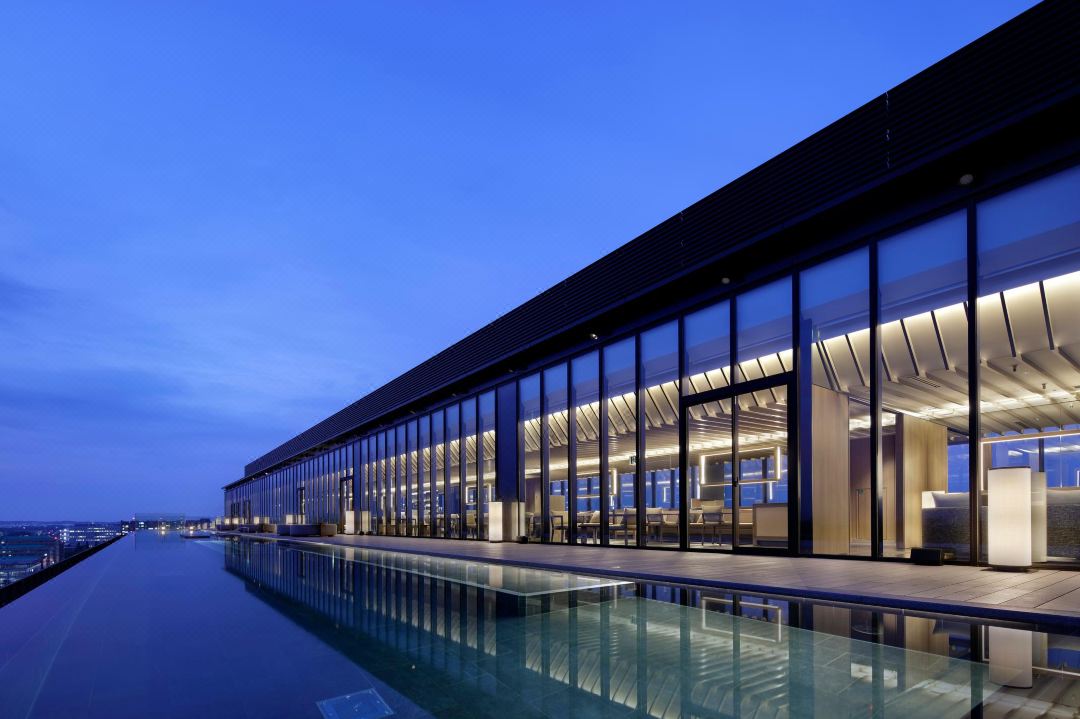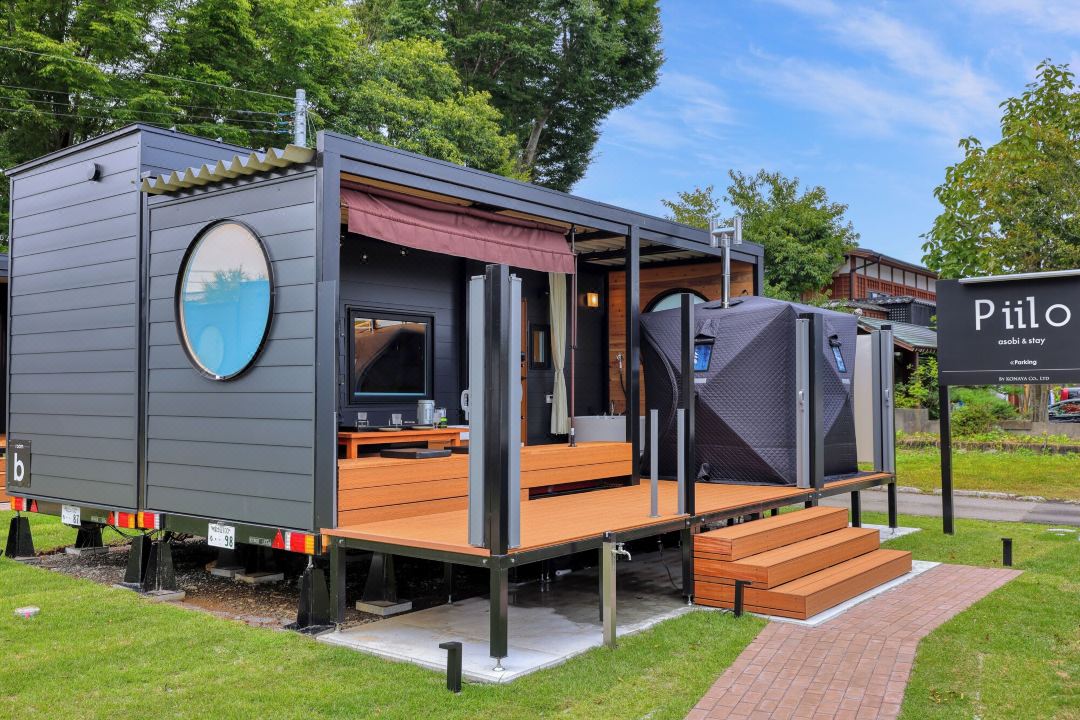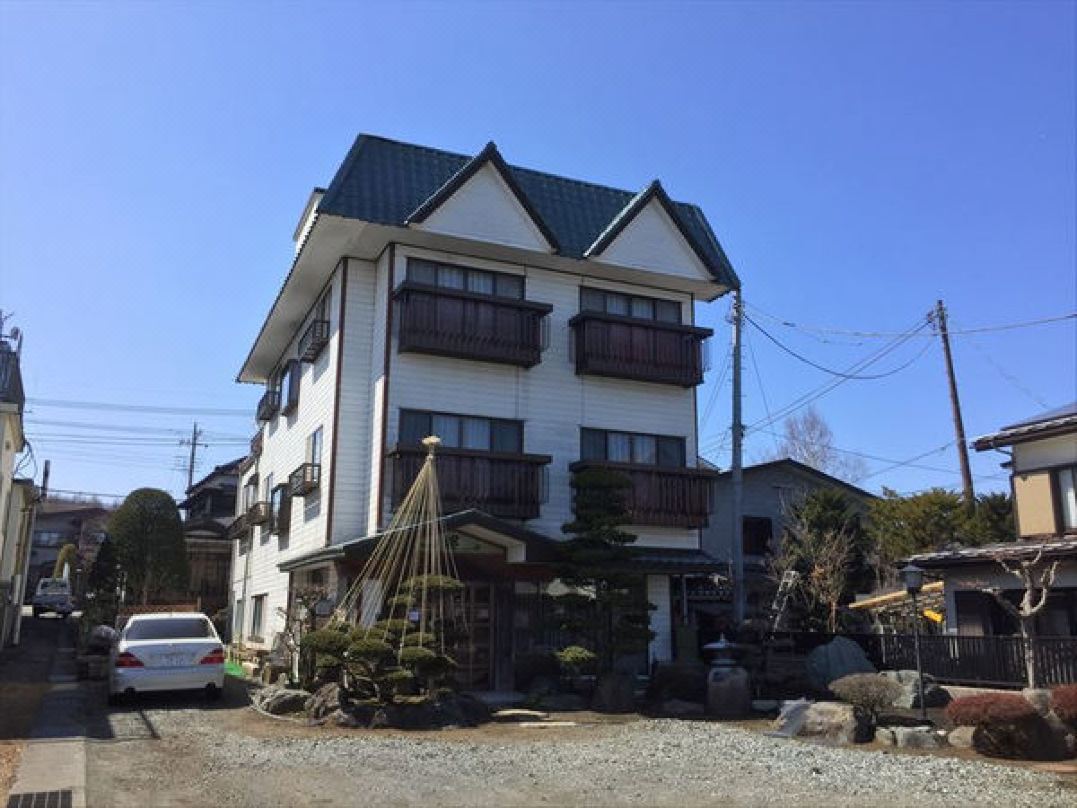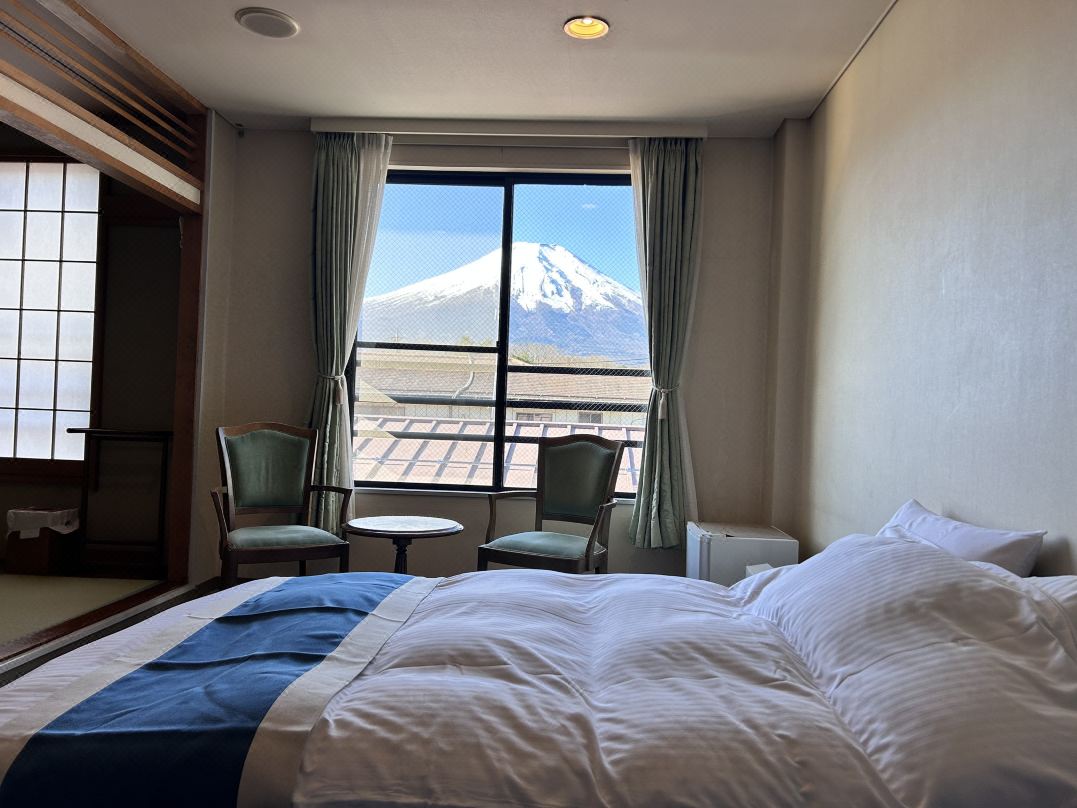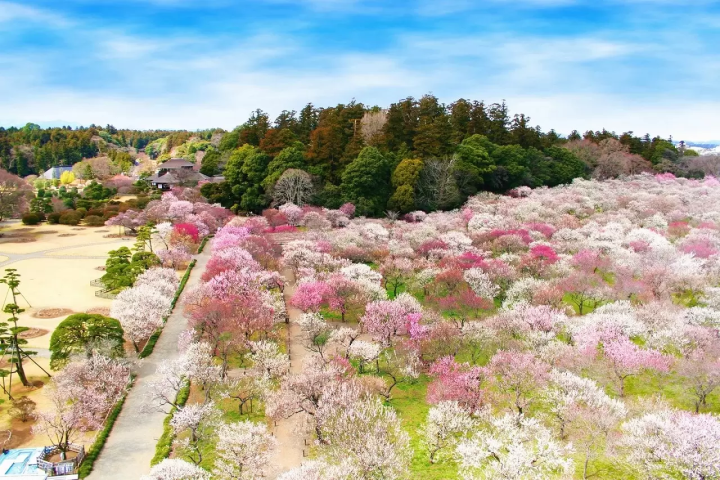Nemophila Flowers: 5 Splendid Locations to Visit in Spring 2025

The endless fields covered in nemophila flowers are some of the most photogenic sights during spring in Japan. This article introduces five locations to view nemophila, from the famous Hitachi Seaside Park to parks in Tokyo and Osaka, as well as one near Mt. Fuji!
Nemophila Flowers, the Highlight of Spring in Japan
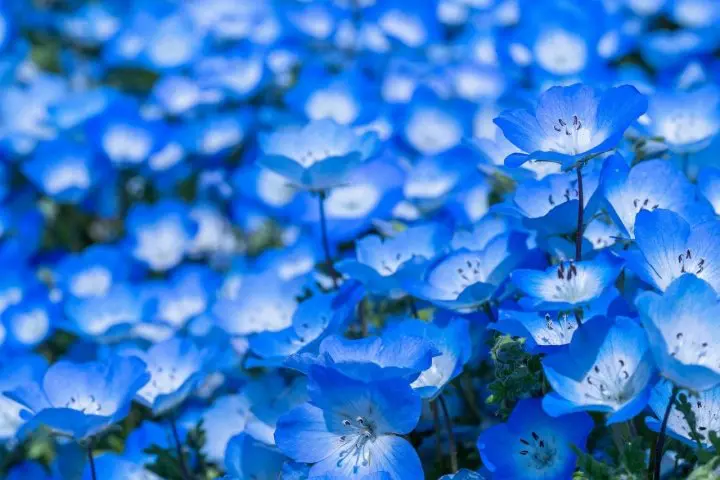
Photo by Pixta
A carpet of stunning blue flowers across a large open field! Nemophila, also known as "baby blue eyes," is a blue flower that blooms from mid-April to early May.
After cherry blossoms, the nemophila are some of the most eagerly awaited flowers during spring in Japan. Visitors flock to gardens and parks to enjoy them every year.
We introduce five iconic and easily accessible locations to view nemophila flowers in Japan.
5 Nemophila Locations in Japan
1. Hitachi Seaside Park (Ibaraki)
2. Showa Memorial Park (Tokyo)
3. Tsurumi Ryokuchi Park (Osaka)
4. Maishima Seaside Park (Osaka)
5. Near Mt. Fuji! Lake Yamanakako Hana no Miyako Park (Yamanashi)
1. Hitachi Seaside Park - Ibaraki
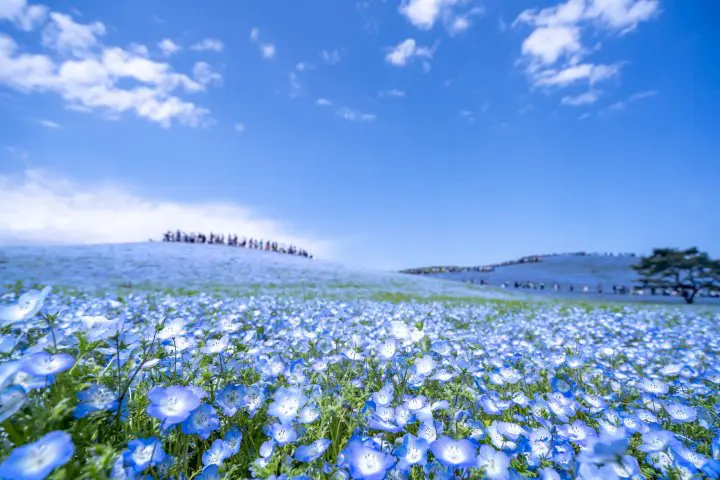
Photo by Pixta
Famous for its splendid seasonal flowers throughout the year, Hitachi Seaside Park in Ibaraki is especially popular as a spring travel destination.
The nemophila flowers bloom on Miharashi Hill, which offers panoramic views of the entire park and the ocean. The seeds of nemophila are planted in early February and the flowers reach the peak of bloom around late April.
The entire hillside covered in nemophila flowers against the stunning backdrop of the ocean makes for a once-in-a-lifetime experience! The park also offers nemophila-inspired food and beverages, from baby blue colored soft serve ice cream to nemophila shaped cookies.
After the nemophila are gone, the kochia shrubs, or fire brushes, are planted in the same location on Miharashi Hill. These shrubs grow and turn fiery red by October.
See beautiful Nemophila and Wisteria on a one-day tour from Shinjuku!
Hitachi Seaside Park
Business Hours
Sunday to Thursday: 9:30 - 17:00
Friday to Saturday: 9:30 - 16:30
*Please note the park is closed on Tuesdays.
Access: A 15-minute bus ride from JR Katsuta Station
Hotels near Hitachi Seaside Park
2. Showa Memorial Park - Tokyo

Photo by Pixta
Showa Memorial Park in Tokyo provides one of the best chances to view the nemophila flowers at your convenience. The park is only a 2-minute walk away from Nishi-Tachikawa Station.
The nemophila flowers are in the mountain stream square, which is located near the Serpentine area in the heart of the park. Visitors flock to take beautiful up-close pictures of the nemophila and enjoy the park's many sites. Around the same time, the tulips are also in bloom. The tulip garden is one of the most famous attractions at Showa Memorial Park.
Bicycle rental outlets are located at the park entrances and charge 420 yen for three hours or 530 yen for the entire day. Alternatively, there is a park train (on wheels) that connects the different areas of the park; a ride costs 310 yen.
Showa Memorial Park
Business Hours
9:30 to 17:00 (March to October)
9:30 to 18:00 (weekends and holidays between April and September)
9:30 to 16:30 (November to February)
Hotels near Showa Kinen Park
3. Tsurumi Ryokuchi Park - Osaka
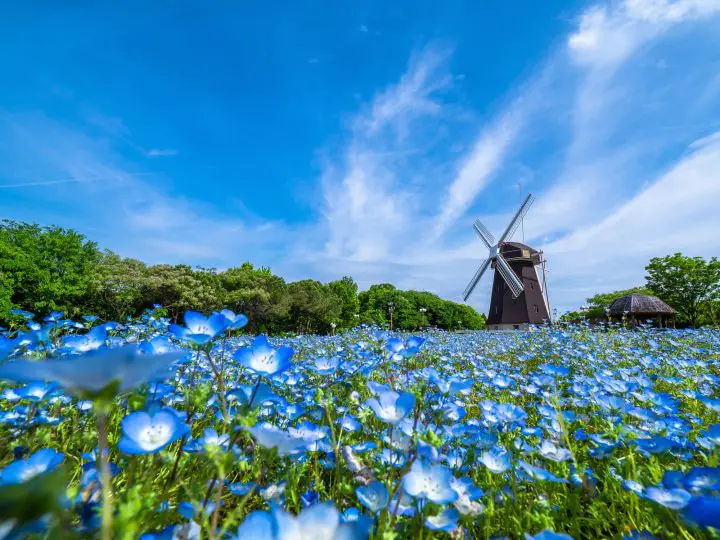
Photo by Pixta
Tsurumi Ryokuchi Park in Osaka is best known for the hillside carpet of nemophila under the watchful gaze of a European-style windmill. The nemophila flowers bloom within the "mountain area" of the park. Visit in the morning if you wish to avoid the crowds.
The park is a paradise for botanical lovers, boasting one of the largest greenhouses in Japan that is full of exotic plants.
Flower Expo Tsurumi Ryokuchi Park
Opening Hours
9:30 to 17:30. Entry is free!
Access: Two-minute walk from the Tsurumi Ryokuchi Station.
4. Maishima Seaside Park - Osaka
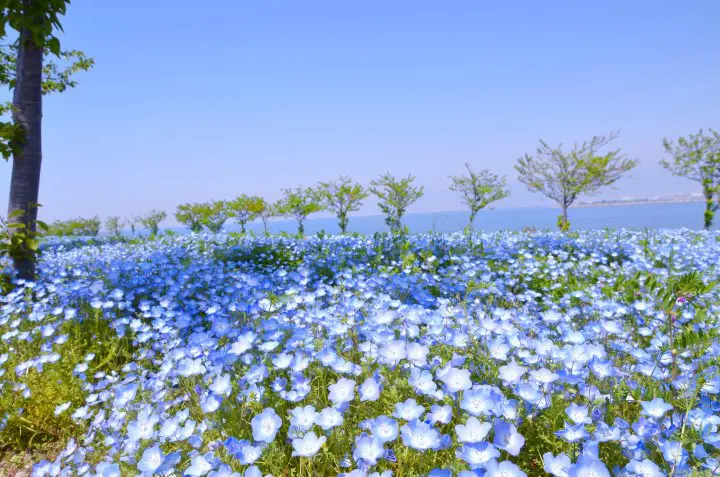
Photo by Pixta
A trip to view the nemophila in western Japan wouldn't be complete without a visit to Osaka Maishima Seaside Park. With the open sea of Osaka Bay, the vivid blue spring sky, and the baby blue nemophila blooms, the park is one of the most picturesque places to view these flowers.
Osaka Maishima Seaside Park is also known for its annual nemophila festival that attracts many flower enthusiasts.
Osaka Maishima Seaside Park
Opening Hours
Monday to Friday: 9:00 to 17:00
Saturday and Sunday: 9:00 to 18:30
Access: A bus from Yumesaki Station (JR) or Cosmo Square (Osaka Metro)
Tickets
1,200 yen for adults (over junior high school age)
600 yen for children (aged between 4 years old and elementary school age)
5. Near Mt. Fuji! Lake Yamanakako Hana no Miyako Park - Yamanashi
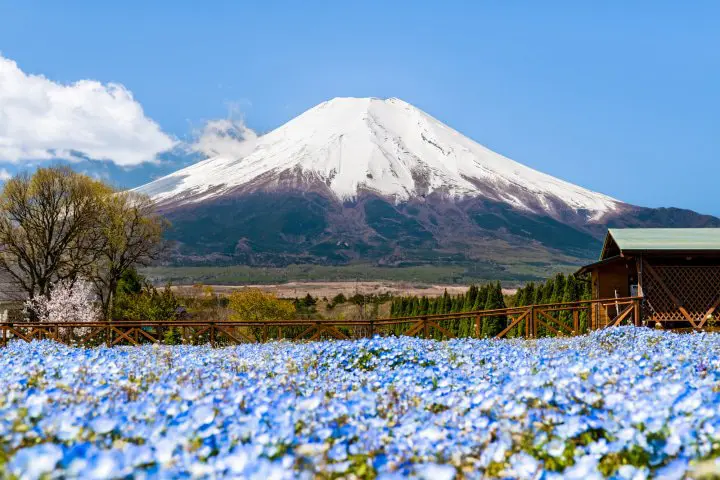
Photo by Pixta
What could be more photogenic than fields of nemophila in front of the most iconic mountain in all of Japan? Lake Yamanakako Hana no Miyako Park in Yamanashi is the perfect place to take in the sights of Lake Yamanaka with a botanical twist.
Many of the park’s paths are designed to be wheelchair-accessible and family-friendly. Wheelchair rentals are also available. Admission to the flower field is free, but a small fee is required to enter areas like Seiryu no Sato, home to the Myojin Waterfall, a water park, and a well-curated greenhouse.
Lake Yamanakako Hana no Miyako Park
Opening Hours
8:30 to 17:30
Access: From Tokyo, take a train via the JR Chuo Line and the Fujikyu Rapid Line. Alternatively, you can take a highway bus from the Shinjuku Bus Terminal.
Hotels near Lake Yamanaka Flower City Park
FAQ
Where can I see nemophila in Japan?
Nemophila, or baby blue eyes flowers, are a popular spring attraction in Japan known for creating stunning carpets of blue blooms. One of the most famous places to see nemophila is at Hitachi Seaside Park in Ibaraki Prefecture, particularly during the annual Nemophila Harmony event from late April to mid-May. The vast Nemophila Hill in Hitachi Seaside Park showcases millions of nemophila flowers in full bloom, creating a mesmerizing blue landscape that attracts visitors from around the world. Additionally, Ashikaga Flower Park in Tochigi Prefecture is renowned for its wisteria displays but also features nemophila as part of its spring flower collections, offering another opportunity to admire these delicate blue flowers in a picturesque setting.
How do I go to Osaka Maishima Seaside Park?
To access Osaka Maishima Seaside Park in Japan, there are several transportation options available. One route involves taking the train by starting at Osaka Station and transferring to the JR Osaka Loop Line to Bentencho Station before transferring to the JR Sakurajima Line at Nishikujo Station, then proceeding to Cosmosquare Station where you can catch a Nankai Bus to the park. Alternatively, driving to the park is feasible, with parking facilities on site for visitors. For a more scenic journey, consider taking a ferry from Universal City Port to Maishima Island, offering a unique perspective of the area's surroundings. By utilizing these transportation methods, you can easily reach Osaka Maishima Seaside Park to enjoy its green spaces, art exhibits, and scenic waterfront views.
What are the blue flowers in Japan called?
The blue flowers commonly seen in Japan, particularly in famous spots like Hitachi Seaside Park and Ashikaga Flower Park, are known as Nemophila. These delicate and charming flowers, also called "baby blue eyes," create stunning blue carpets that attract visitors during the spring season with their vibrant hue and beauty. Nemophila is a popular spring attraction, adding to the colorful tapestry of Japan's floral landscape alongside cherry blossoms, wisteria, and other seasonal blooms.
How long does nemophila last?
Nemophila flowers, known for their vibrant blue blooms, typically have a blooming period that lasts for several weeks, generally spanning from late April to mid-May in Japan. During this time, visitors can enjoy the stunning sight of these delicate flowers blanketing fields or parks like Hitachi Seaside Park in Ibaraki Prefecture. The exact duration of the blooming season can vary depending on local weather conditions, but typically, nemophila flowers remain in full bloom for a few weeks, offering a spectacular display before their petals fade and the season transitions to other floral attractions.
What is another name for Nemophila?
Another name for Nemophila, particularly in English, is "baby blue eyes." This moniker perfectly describes the soft blue color and the delicate appearance of these charming flowers. In addition to their botanical name, Nemophila, referring to their genus within the Hydrophyllaceae family, the descriptive term "baby blue eyes" is commonly used to evoke the flowers' gentle and appealing nature, making them a beloved sight in gardens and natural landscapes.
Enjoy the Nemophila Flowers in Japan!
With their delicate appearance, nemophila are a highlight of spring in Japan. We hope you enjoy your trip to nemophila destinations. Don't forget your camera!
Read also
Main image by Pixta
Travel writer and assistant editor at MATCHA with extensive travel around the Osaka, Kyoto, and Wakayama areas. A Kansai insider who knows their Akashiyaki from their Takoyaki, Iain enjoys getting authentic stories from traditional craftspeople and interesting creators. Particularly fond of temples and shrines, Iain delves deep into the crossroads of tradition and modernity in his eight-plus years living and writing about Japan.








